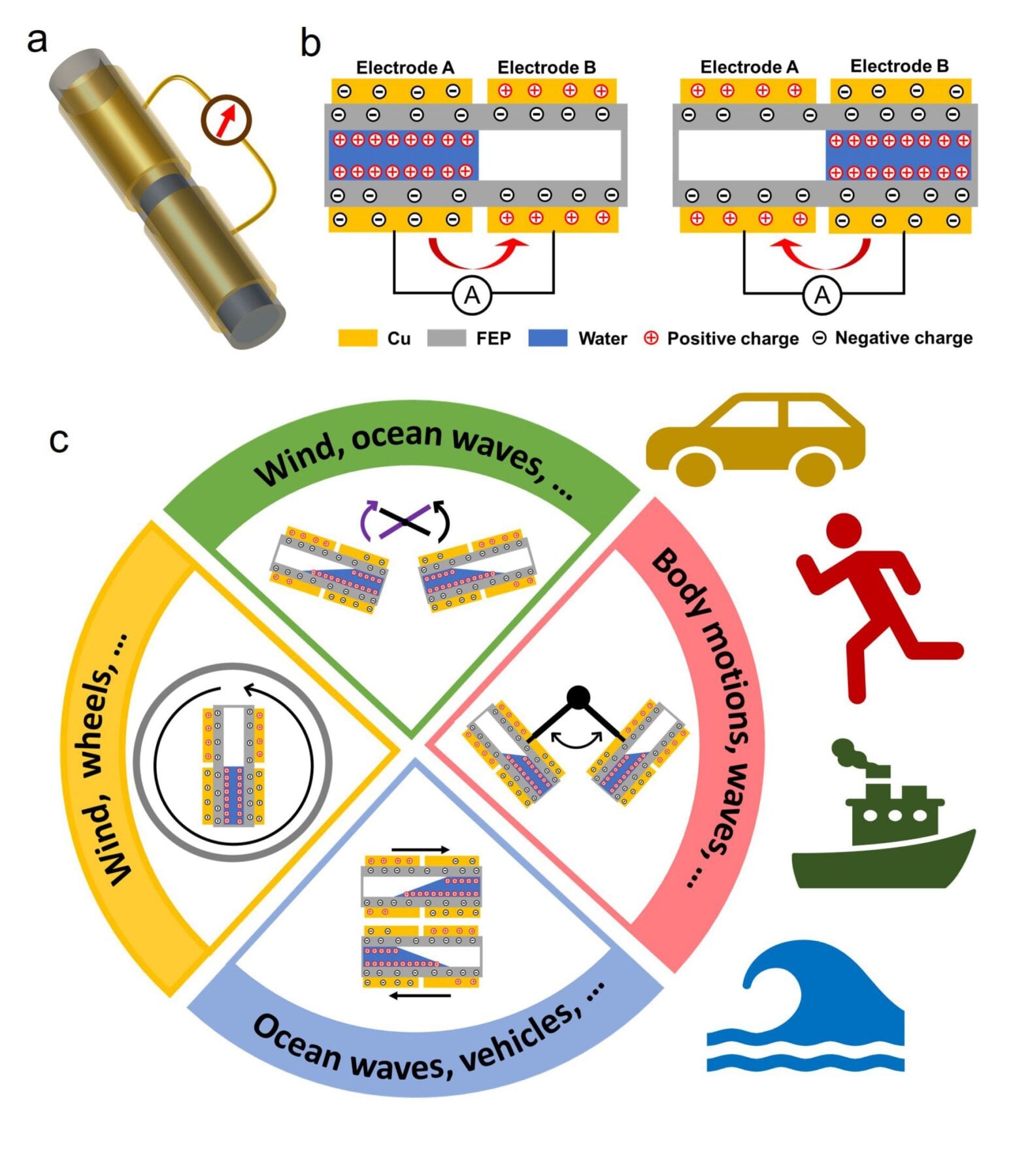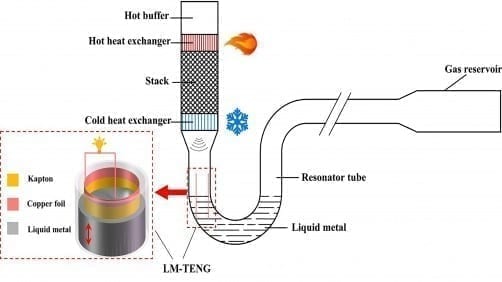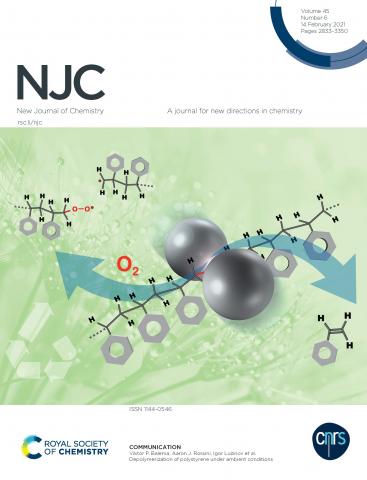
The team encapsulates water in a finger-sized tube. When water moves in the tube between regions of the two electrodes, triboelectrification happens and electric currents can be generated. Taking advantage of the flexibility of water, the WT-TENG can be operated in various modes, including rotation, swing, seesaw, and horizontal linear modes.
A research team from the Faculty of Engineering of The Chinese University of Hong Kong (CUHK) has recently developed a water-tube-based triboelectric nanogenerator that can efficiently convert various irregular and low-frequency mechanical energies, including ocean wave energy, into electricity, providing a new avenue for the development of “blue energy”.
The ocean covers about 70% of the Earth’s surface area and is the largest reservoir of energy. Researchers have been exploring the approach for harnessing ocean energy to solve the world energy crisis and pollution problems caused by thermal power generation. The nanogenerator, including piezoelectric, triboelectric, and pyroelectric nanogenerators, is one of the key technologies for mechanical energy conversion. The triboelectric nanogenerator (TENG) makes use of the triboelectric effect and electrostatic induction to harvest mechanical energy based on contact or sliding electrification.
However, conventional TENG device is often based on solid/solid contact, and it is hard to ensure the contact intimacy of the two tribo-materials. In the meanwhile, the material surfaces will wear or become damaged after long-term friction. Also, the solid/solid-based TENGs need shell structures and/or mechanical components such as springs, holders, and rotors to harvest random vibration energy. The complex structure will reduce the efficiency of energy harvesting.
The research team led by Prof. Zi Yunlong, Assistant Professor of the Department of Mechanical and Automation Engineering at CUHK, has recently overcome the above technical limitations and developed a water-tube-based TENG (WT-TENG) for irregular and low-frequency environmental energy harvesting, such as water waves. They encapsulated water in a finger-sized tube (FEP). When water moves in the tube between regions of the two electrodes, triboelectrification happens and electric currents can be generated. Taking advantage of the flexibility of water, the WT-TENG can be operated in various modes, including rotation, swing, seesaw, and horizontal linear modes, to harvest energy from diverse mechanical movements in the environment, such as ocean waves, wind, body and vehicle movements. Due to the high contact intimacy of water and the tube surface, the output volumetric charge density of the WT-TENG is significantly enhanced, reaching 9 mC/m3 at a frequency as low as 0.25 Hz, which is beyond all previous reports.
Moreover, just like toy building bricks, multiple small WT-TENG units can be easily combined and integrated as one larger unit and realise multiplied electric outputs. Researchers designed two power generation units. One is a box with 34 WT-TENG units which was placed in the sea to collect ocean wave energy. Another one is a wristband composed of 10 WT-TENG units. A researcher put it on and kept swinging her arms for body motion energy harvesting. The peak power generations of the two tests were both enough to drive 150 LED light bulbs.
Prof. Zi Yunlong stated, “Previous designs of ocean energy harvesters have been equipped with electromagnetic-based generators which are large in size and heavy, and will only generate power if the frequency of ocean waves reaches a certain high level. Our latest research has overcome the technical hurdles and will promote the use of nanogenerators, especially in “blue energy” harvesting, offering a new direction for the development of renewable energy to achieve carbon neutrality.”
Original Article: Leading Blue Energy Revolution: CUHK Faculty of Engineering Develops Water-Tube-Based Triboelectric Nanogenerator for Efficient Ocean Wave Energy Harvesting
More from: Chinese University of Hong Kong | City University of Hong Kong
The Latest Updates from Bing News & Google News
Go deeper with Bing News on:
Triboelectric nanogenerator
- “Drinking Bird” Becomes an Evaporation-Driven Triboelectricity Energy Harvester
Researchers combined the drinking bird toy with a triboelectric arrangement to create a high-voltage energy-harvesting scheme.
- Scientists unveil self-cleaning solar panel technology poised to revolutionize energy sector: 'A major step'
This is the type of technological advancement that we can hope and expect to see more of as solar and wind continue to become more widespread. Scientists unveil self-cleaning solar panel technology ...
- Loughborough University develops nanogenerators for ‘smart clothing’
The research, led by the University’s Wolfson School of Mechanical, Electrical and Manufacturing Engineering, has used 3D printing techniques to create a new Triboelectric Nanogenerator (TENG) design.
- Loughborough University project helps further develop nanogenerators for “smart clothing”.
A Loughborough University project is helping in the drive to develop nanogenerator technology which can lead to “affordable” clothing capable of sensing how healthy we are.
- Researchers Develop Simple Way To Harvest More “Blue Energy” From Waves
As any surfer will tell you, waves pack a powerful punch. We're now making strides toward harnessing the ocean's relentless movements for energy, thanks to advancements in "blue energy" technology. In ...
Go deeper with Google Headlines on:
Triboelectric nanogenerator
[google_news title=”” keyword=”triboelectric nanogenerator” num_posts=”5″ blurb_length=”0″ show_thumb=”left”]
Go deeper with Bing News on:
WT-TENG
- Oil Prices Stabilize, Middle East Tensions Remain in Focus
Oil prices edged higher on Tuesday, after falling in the previous session, as investors continued to assess the risk from geopolitical concerns in the Middle East. Global benchmark Brent crude oil ...
- Crude stays below $87, watch on West Asia tension despite Iran's assurance of no retaliation
Both benchmarks had been down more than $1 a barrel. Early on Friday, prices for WTI and crude climbed than $3 a barrel, after explosions were heard in the Iranian city of Isfahan in what sources desc ...
- Oil Dips As Middle East Tensions Fail To Impact Trading - For Now
Oil on Monday dipped as jittery traders began to take faith in reports that crude supplies have to date not been affected by the Middle East hostilities, and that fundamentals are shaping up to be ...
- Oil futures fall as fears of a wider Middle East war fade
Oil prices fell by more than 1% on Monday, as the market focus switched to fundamentals after Israel and Iran played down the risk of an escalation of hostilities following Israel's apparently small ...
- US crude futures climb back into positive territory
U.S. crude futures returned to positive territory on Monday after falling on easing fears of a wider Mideast conflict. U.S. West Texas Intermediate crude was up 0.03 cents or 0.04% at $83.17 a barrel ...
Go deeper with Google Headlines on:
WT-TENG
[google_news title=”” keyword=”WT-TENG” num_posts=”5″ blurb_length=”0″ show_thumb=”left”]










